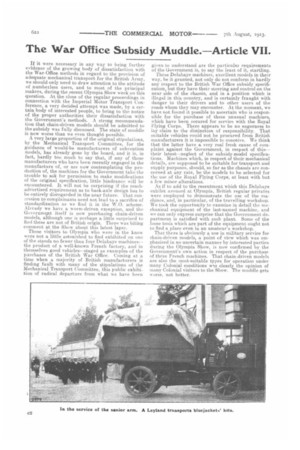The War Office Subsidy Muddle.—Article VII.
Page 10

If you've noticed an error in this article please click here to report it so we can fix it.
If it were necessary in any way to bring further evidence of the growing body of dissatisfaction with the War-Office methods in regard to the provision of adequate mechanical transport for the British Army, we should only need to draw attention to the attitude of numberless users, and to most of the principal makers, during the recent Olympia Show week on this question. At the close of the regular proceedings in connection with the Imperial Motor Transport Conference, a very decided attempt was made, by a certain body of interested people, to bring to the notice of the proper authorities their dissatisfaction with the Government's methods. A strong recommendation that chain-driven models should be admitted to the subsidy was fully discussed. The state of muddle is now worse than we even thought possible. A very large proportion of the original stipulations, by the Mechanical Transport Committee, for the guidance of would-be manufacturers of subvention models, has already gone by the board, and it is, in fact, hardly too much to say that, if any of those manufacturers who have been recently engaged in the manufacture of, or are now contemplating the production of, the machines for the Government take the trouble to ask for permission to make modifications of the original specification, little hindrance will be encountered. It will not be surprising if the muchadvertised requirement as to back-axle design has to be entirely disregarded in the near future. That concession to complainants need not lead to a sacrifice of standardization as we find it in the W.O. scheme. Already we have a worm-driven exception,. and the Govornmerit itself is now purchasing chain-driven models, although one is perhaps a little surprised to find these are not of British origin. There was biting comment at the Show about this latest lapse. Those visitors to Olympia who were in the know were not a little astonished to find exhibited on one of the stands no fewer than four Delahaye machines-the product of a well-known French factory, and in themselves good vehicles—staged as examples of the purchases of the British War Office. Corning at a time when a majority of British manufacturers is finding fault with many of the stipulations of the Mechanical Transport Committee, this public exhibition of radical departure from what we have been given to understand are the particular requirements of the Government is, to say the least of it, startling. These Delahaye machines, excellent models in their way, be it granted, not only do not conform in hardly any respect to the British War Office subsidy specification, but they have their steering and control on the near side of the chassis, and in a position which is illegal in this country, and is certainly fraught with danger to their drivers and to other users of the roads whom they may encounter. At the moment, we have not found it possible to ascertain who is responsible for the purchase of these unusual machines, which have been secured for service with the Royal Flying Corps. There appears to be no eagerness to lay claim to the distinction of responsibility. That suitable vehicles could not be procured from British manufacturers it is impossible to conceive. We think that the latter have a very real fresh cause of complaint against the Government, in respect of this-their latest—neglect of the subsidy-model specifications. Machines which, in respect of their mechanical details, are supposed to be suitable for transport and supply purposes, should, so far as the chassis are concerned at any rate, be the models to be selected for the use of the Royal Flying Corps, at least with but a few minor alterations.
As if to add to the resentment which this Delahaye exhibit aroused at Olympia, British regular privates were employed to demonstrate the use of the machines, and, in particular, of the travelling workshop. We took the opportunity to examine in detail the mechanical equipment of the last-named machine, and we can only express surprise that the Government department is satisfied with such plant. Some of the loose toois which are part of the equipment ought not to find a place even in an amateur's workshop. That there is obviously a use in military service for chain-driven models, a point of view which was emphasized in no uncertain manner by interested parties during the Olympia Show, is now confirmed by the Government's own action in respect of the purchase of these French machines. That chain-driven models are also the most-suitable types for operation under many Colonial conditions was clearly the opinion of many Colonial visitors to the Show. The muddle gets worse, not better.




















